![]()
![]()
![]()
Use LEFT and RIGHT arrow keys to navigate between flashcards;
Use UP and DOWN arrow keys to flip the card;
H to show hint;
A reads text to speech;
8 Cards in this Set
- Front
- Back
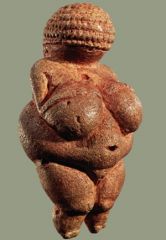
a. What is the significance of this work?
b. What is the medium? |
a. The emphasis is on the female and fertility, this figure is possibly a fertility figure. Pages 17-18
b. Limestone. |
|
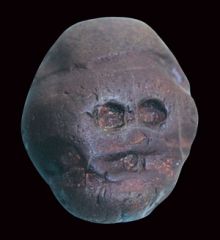
a. Why is this significant?
b. Where was this found? |
a. It is perhaps that singular step toward representation. Pages 15-16
b. Makapansgat, South Africa. Page 15 |
|
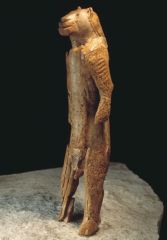
a. How is this work significant?
b. What is the medium? c. What is the size? d. How is this work important? |
a. It represents a human figure, either male or female and a directed effort at figural representation. Page 17
b. Mammoth Ivory. Page 17 c. Almost one (1) foot or twelve (12) inches. Page 17 |
|
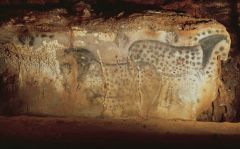
a. Why is this work significant?
b. How is the "negative handprint" achieved? c. Where is this located? |
a. That this work had meaning for the Paleolithic peoples cannot be doubted. The markings and the figural representation on the walls indicate purpose, and the handprints possibly could mean a signature of sorts. Pages 20-22
The painter placed his hand on the surface and then blew, brushed, or spat pigment on his hand creating an outline and thus the "signature". Pages 20-22 c. Pech-Merle, Lot, France. Page 20 |
|
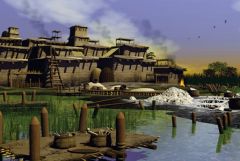
a. How is this significant?
b. What was the construction material? c. What urban design does Çatal Höyük present? d. Why are the shrines significant? |
a. It indicates a thoughtful process in creating and designing an urban environment, it presents careful planning, guarding and protecting the city, it is a consequence of civilization. Page 25
NEOLITHIC b. Mud brick. Page 26 c. Thus far the excavated rooms indicate a domestic living arrangement, designed for working, cooking, eating, and sleeping. Page 26 d. They indicate the thoughtful process of intellectualizing a "greater being." The interior decorative programs illustrate these rooms were special to the people. Page 26 |
|
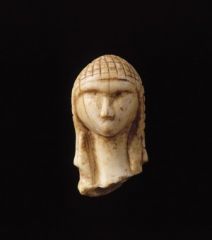
a. What types of tools and techniques did the artist use to create this work?
b. Why is the gender of this work uncertain? c. What is the controversy surrounding this work? |
a. The sculptor used a variety of stone burins and techniques--cutting, incising, grinding, gouging, polishing--to create the head and to represent the anatomical details, especially the elaborate braided coiffure.
b. The gender is uncertain, but because of the long hair and the much higher frequency of representations of women than men in Paleolithic sculpture, researchers have assumed that the head is female. c. This tiny head is one of the few detailed representations of a human face in Paleolithic art. Most scholars accept the piece as genuine, although some have questioned its authenticity because of the unusual inclusion of several facial features. |
|

a. Why is this work dubbed the "Chinese Horse"?
b. What do scholars think the rounded belly means? c. What abstract motif appears here that is frequently found in Paleolithic paintings? |
a. It is one of several in the Axial Gallery that reminded them of the stylized representations of horses in Chinese art.
b. Interpretations of the details of this representation vary widely. Some scholars believe that the rounded underbelly of the horse indicates that the painter intended to communicate that the horse is pregnant. If so, the "Chinese horse" lends support to the theory that the purpose of cave paintings was to promote the fertility of the animals on which Paleolithic humans depended for food and clothing (see "Art in the Old Stone Age," Chapter 1, page 21). But this painting also includes two objects that may be arrows or feathered darts, which have suggested to others that the cave paintings were aids in hunting and killing the animals. c. One of the abstract motifs that frequently appears in Paleolithic paintings is also present in this work. Above the horse's mane is a grid pattern that some scholars have interpreted as a trap, but others think may be a primitive form of writing. Rows of painted dots also regularly appear on the walls of French caves. They may be evidence for an early counting system or may also carry a verbal message. |
|
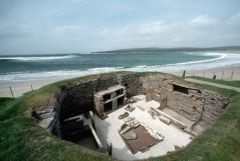
a. How was this house discovered?
b. What great megalithic structures does this house preceed? c. What design feature was built expressly for the head of the household? |
a. Archaeologists discovered the site in 1850 after a severe storm washed away the sand dunes that had concealed the Neolithic village there for millennia.
b. The stone houses of Skara Brae are the predecessors of the great megalithic henges of the British Isles at Stonehenge c. In front of the cupboard was a stone seat, undoubtedly for the head of the household, who from his seated position could greet visitors entering through the door. |

